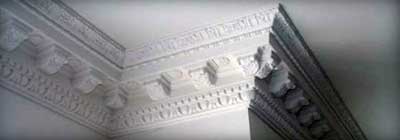
| Home |
| About us |
| Photo Archive |
| Clients |
| Contact |
| Drywall |
| Fibrous |
| Cornice |
| Fibrous plaster |
Fibrous plaster is a very advantageous method of choice when casting your decorative moldings. Fibrous plaster is composed of plaster laid upon a backing of canvas stretched over a wood or steel frame. It has been given the name "stick and rag" by plasterers, which is a rough description of the materials used in this plastering process.
Fibrous plaster is used in casting circular and enriched moldings for columns, girders, and various types of ornamental work. It is usually worked in a shop and then attached to something else as a decoration by nails, glue, hooks, or fixed in position by some other method. This type of molding saves time attributed to the delay of working on the ornamental projects on site and in position. This type of work is also much used for temporary work, such as exhibition buildings.
A French modeler named Leonard Alexander Desachy first took out a patent in 1856 for "producing architectural moldings, ornaments and other works of art, with surfaces of plaster." his method used materials such as plaster, glue, wood, wire, and canvas or other woven fabrics. Although the modern uses of this type of plastering technique can be said to have started then, it was widely used by people dating as far back as the Egyptians and probably predates even them. The Egyptians used it for decorating coffins and making masks, some of which are still preserved today, proving that when linen is stiffened with plaster, it can create very long-lasting products.
Fibrous plaster has many advantages over other choices. It is a lot lighter and better reinforced so moldings can be transported easier to the site where they are going to be installed. The use of modular cast moldings not only can make your finished products more uniform during installation, but also saves a lot of time and effort. For example, installing a pre-made figure into a space with specific dimensions for the figure saves in having to model each figure from scratch and installing them individually. Doing this costs less for the decorations themselves, and is alot more efficient for your builders, costing you less in their work as well.
Fibrous plaster is not only used in designing or decorating houses, but also in theatres, music halls, museums, and many other places where a grand effect is required. It allows those working with a limited budget and space to work in more choices and better products available to them. Theatres are renown for having access-ways that are built behind their facades, as well as lighting rigs that are cut through the ceilings. If this was done with solid plaster, or other material, their lavishly ornamented decorations would weigh so much it would require a massive structural support. This support would eliminate any workable space provided by the lighter materials. In the past, fibrous plaster allowed the mass-production of extremely decorative moldings such as cornices and ceiling roses that were a major part of Victorian and Edwardian interior design. Other areas that may be of interest:
|
|
||